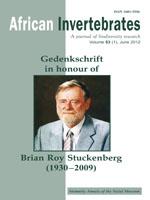Megaselia guentermuelleri sp. n. with a remarkable wing pattern is described from Mali. The new species readily differs from all other Megaselia, including those with ornamented wings, by the presence of a large pigmented swelling in its wing, among other features.
INTRODUCTION
It is needless to re-iterate statements on the size and taxonomic complexity of the enormously large genus Megaselia (cf. Hartop & Brown 2014), while life histories of its constituent species are covered in the fundamental treatment of the Phoridae by Disney (1994) and in a score of his subsequent publications.
Afrotropical species of Megaselia are covered patchily (Meunier 1905, 1910; Beyer 1960, 1965; Disney 1978, 1980, 1982, 1989, 1991, 2004a, b, 2005, 2006a–c, 2007, 2010; Disney et al. 2013) and grossly insufficiently. The present communication reports on a new Megaselia member with the most remarkable wing ornament. Compared to some other scuttle fly genera (e.g. Kung & Brown 2000), patterned wings occur in Megaselia very infrequently (M. lelenpi Beyer, 1960; M. maculifera Beyer, 1965; and M. dickoni Wakeford & Disney, 1994). Recently, another amazing Megaselia of this sort has been described from a tropical forest in Costa Rica (Hartop & Brown 2014).
MATERIAL AND METHODS
The material was collected in Kéniéroba (south-western Mali) and preserved in 70% ethanol. The only paratype of the new species was dissected for description and mounted in Berlese Fluid on slide (as per Disney 1983).
Hartop and Brown (2014) suggested a ground-breaking method of description for Megaselia species, which has been accepted in the present paper. They thoroughly discussed characters that should be used, but excluded some as being seemingly subjective. Thus, colours have been omitted from their template. One cannot help but totally agree that precise, or numerical, description of absolute colours is the most ungratifying task. Still those are useful tools in species recognition and have been successfully used as such for decades, even centuries, without reference to colour palettes. Human languages possess sufficient vocabularies for description of colours that occur in nature, with one of the richest being found in English (e.g. Kay & McDaniel 1978). There are certain differences in colour perception across cultures (e.g. Regier & Kay 2009); nevertheless, eager students should be able to find most appropriate words for their observations. Hartop and Brown's suggestion to replace ‘verbose’ descriptions with ‘a well taken habitus photo’ is not always achievable, for this requires professional equipment and software that may not be readily available to a taxonomist. Moreover, results of such exercises depend on other variables, e.g. light source colour temperature and the researcher's experience.
Other characters like those of the abdomen are also included in the template, as they will undoubtedly prove useful for automated identification of Megaselia species in the future.
The types are deposited in the collection of the Steinhardt Museum of Natural History and Israel National Center for Biodiversity Studies, Tel Aviv University (TAU).
TAXONOMY
Genus Megaselia Rondani, 1856
Megaselia guentermuelleri
sp. n.
Figs 1–6; Table 1
Etymology: The species is dedicated to Dr Günter C. Müller, whose organizational skills and collecting efforts in Mali resulted in the discovery of this remarkable species.
Description:
Male.
Body length: 2.5 mm.
Colour: Frons dark brown, antenna brown, palpus pale yellow; scutum and scutellum yellow and slightly ochreous, pleura light yellow except for brown to black posterior part of metapleuron; all legs are yellow except for darkened apex of hind femur; abdominal tergites uniformly brown, abdominal sternites unsclerotised except for S6 represented by paired pigmented patches; epandrium brown, paired hypandrial lobes light brown, anal tube pale yellow.
Wing: Large heavily pigmented sclerotised bean-like swelling exists below RS at base of 2nd thin vein, with a paler extension protruding between 2nd and 3rd thin veins.
Female. Unknown.
Comparison: Having a relatively long costa, two strong scutellar bristles, only posterodorsals on the hind tibia and ‘Flügel mit ausgedehneter brauner Makel’, the new species runs immediately to M. leleupi Beyer, 1960 in Beyer's (1965: 53) key. However, it readily differs from the latter, which has been described from female only, in being larger (2.5 vs 1.8 mm) and in having yellow pleura (black in M. leleupi), shorter both costa (CI 0.42 vs 0.53 in M. leleupi) and costal cilia (0.07 vs 0.16 in M. leleupi), and different costal ratios (3.8 : 2.6 : 1 vs 2.4 : 2.0 : 1 in M. leleupi). If one ignores this option and proceeds further with Beyer's key, identification of the specimens on hand becomes confusing. From the Neotropical M. shadeae Hartop & Brown, 2014 with a large, bubbled and pigmented wing spot, the new species easily differs by the position and shape of its wing ornament, shorter costa and narrower RS fork, among other features (cf. Hartop & Brown 2014).
Holotype (in ethanol): ♂ MALI: Kéniéroba [12°06′26″N 08°19′58″W], 330 m. 27.vii.2014. G. Müller & V. Kravchenko, fogging (TAU).
Paratype (dissected, on slide): ♂ same data as for holotype, but vii.2014, sweeping (TAU).
Remark: In the absence of corresponding females it would be premature to draw any definite conclusion on the function of the wing ornament in this species. Most probably this is a case of sexual dimorphism, although some role in the flight aerodynamics cannot be ruled out completely.
Figs 1, 2.
M. guentermuelleri sp. n., frontal setation (1) and left side of hypopygium (2). Scale bar = 0.1 mm.

TABLE 1
Description of Megaselia guentermuelleri sp. n.

ACKNOWLEDGEMENTS
I wish to thank my TAU colleagues, Prof. V. Kravchenko, who has made the material available for study, Prof. Z. Yefremova for bringing Hartop & Brown's article to my attention straight upon its appearance, and Drs T. Dayan, N. Dorchin and A. Freidberg, who have greatly facilitated my research at the TAU. I appreciate comments by Drs R.H.L. Disney (Cambridge University, UK) and A. Freidberg (TAU). My current studies of the Phoridae are supported by the Center for Absorption in Science (Ministry of Absorption, Israel) and by Sidney Kaushansky and John Swidler (RSM Richter, Montreal, Canada).






